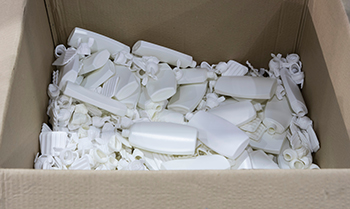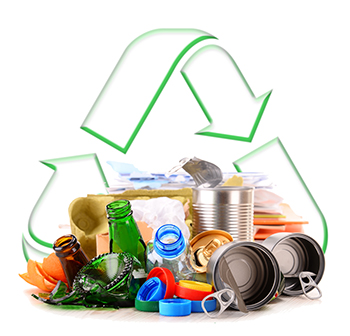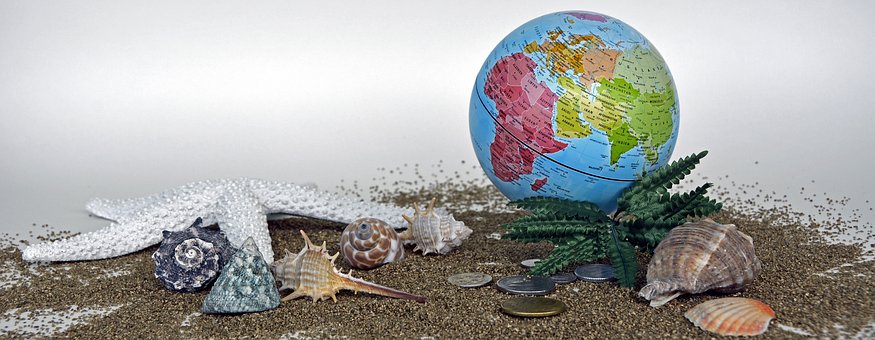Pre- and Post-Consumer Recycled Materials
Easily Defined, But How Easy is Recycling?
In a previous article, we defined pre- and post-consumer recycling, but what differences exist between them? Pre-consumer plastics material (sometimes referred to as Post-Industrial Recycle or PIR) refers to materials sent to recycling streams before reaching a consumer or commercialized use.  Scrap resulting from a manufacturing process is otherwise known as Post-Industrial Recycle. Some injection molded parts have “runners” that are extracted from the product prior to consumer use. (Think of the model car kits with all the extra trim.)
Scrap resulting from a manufacturing process is otherwise known as Post-Industrial Recycle. Some injection molded parts have “runners” that are extracted from the product prior to consumer use. (Think of the model car kits with all the extra trim.)
 Excess material at the start and end of nearly all processes is normal. (Think of a sewing machine and threading the needle, pulling the thread through to serve as a lead, but cut away later and tossed.) Also, it is not uncommon to find defective parts in a production run. Since these remain unused, they are considered post-industrial recyclable material. Many companies collect this PIR and are able to put it back through an internal recycling process. Other companies sell these scrap materials to recyclers who convert them into reusable plastic resins. Most PIR materials are of high quality and the materials are safe for production and cost less to recycle then to make virgin plastics.
Excess material at the start and end of nearly all processes is normal. (Think of a sewing machine and threading the needle, pulling the thread through to serve as a lead, but cut away later and tossed.) Also, it is not uncommon to find defective parts in a production run. Since these remain unused, they are considered post-industrial recyclable material. Many companies collect this PIR and are able to put it back through an internal recycling process. Other companies sell these scrap materials to recyclers who convert them into reusable plastic resins. Most PIR materials are of high quality and the materials are safe for production and cost less to recycle then to make virgin plastics.

Post-Consumer plastics (PCR) as we have learned, are those plastics that we typically discard into our home recycling bins. The benefits of recycling and reusing these post-consumer plastics include a reduction of plastics in the landfills and the reduction in total carbon as new petroleum does not need to be extracted and the byproducts expelled into the atmosphere. Recycling most plastics is less carbon intensive than making new ones.
In contrast, the recycling process is not without stumbling blocks. As plastics vary by chemical makeup, control of inventory is critical. As plastics are recycled their performance suffers as each additional attempt to recycle them causes their properties to diminish. After a plastic is recycled 6 or 7 times it is no longer viable. Think of what happens when you blow up a balloon then let the air out. When you do this over and over you can visually see the wall of the balloon weaken.
 Recycled plastics are often mixed with virgin material to help maintain overall acceptable quality standards for the finished product. This image, in a simplified example, demonstrates how extra materials can be collected and mixed together (as kids so often do) producing very different outcomes. In the case of plastics, if the virgin material is degraded too much, it can cause flashing, which is excess material where it shouldn’t be. This may damage the mold, creating additional expenses requiring tooling maintenance.
Recycled plastics are often mixed with virgin material to help maintain overall acceptable quality standards for the finished product. This image, in a simplified example, demonstrates how extra materials can be collected and mixed together (as kids so often do) producing very different outcomes. In the case of plastics, if the virgin material is degraded too much, it can cause flashing, which is excess material where it shouldn’t be. This may damage the mold, creating additional expenses requiring tooling maintenance.
Another type of post-industrial recycling (or PIR) is reprocessed regrind from multiple industrial sources. Typically, this involves a recycling facility that manages all aspects including additives to derive near virgin quality material from scrap. The complexity is too great to outline, but it is important to note that this process yields near virgin material that is less expensive and more carbon neutral than virgin material. Even more important, the recycling process contributes less environmental damage. Here’s what the Association of Plastic Recyclers had to say, “Recycled plastic is more conserving of expended energy than is virgin plastic. As practiced today, plastics recycling is a lower energy process than the process to synthesize the plastic resins from basic chemicals.”
Did I mention the pandemic? While regrind, more beneficial to our environment, was less costly prior to 2020, since then the pricing of oil has caused virgin material prices to decline. Declining prices increases demand. This causes a decrease in the demand for recycled content. Manufactures must weigh the costs of recycled materials vs. the virgin materials as well as the overall impact on the environment. Other factors, including finances and availability of resins play a role in this decision. Are consumers willing to buy products that are environmentally friendly, even if the cost is higher? Does everyone buy made in the U.S.A. when there is a cheaper option? These are the tough decisions we all will be forced to make.
 Post-consumer recycling (PCR) is waste used by a consumer, disposed of, and ultimately taken to a recycling center. Aluminum cans and newspapers are typical examples of post-consumer items to recycle. The collected materials are broken down – shredded for easier processing. Separation of glass, paper, plastic, and metal occurs. Magnetizing extracts metal by passing the material under a huge magnetic drum. Additional sorting is performed three ways: 1) ballistic sorting, which separates rigid items and flexible items, and fractional sized items. 2) Optical sorting which uses infrared light to scan thousands of objects per minute, and 3) sorting by humans, as a check to all the other systems.
Post-consumer recycling (PCR) is waste used by a consumer, disposed of, and ultimately taken to a recycling center. Aluminum cans and newspapers are typical examples of post-consumer items to recycle. The collected materials are broken down – shredded for easier processing. Separation of glass, paper, plastic, and metal occurs. Magnetizing extracts metal by passing the material under a huge magnetic drum. Additional sorting is performed three ways: 1) ballistic sorting, which separates rigid items and flexible items, and fractional sized items. 2) Optical sorting which uses infrared light to scan thousands of objects per minute, and 3) sorting by humans, as a check to all the other systems.  Once this process is complete, the materials are typically sold to processors where the materials are converted/recycled into manufacturable material. (How Garbage Is Recycled At The US' Largest Recycling Facility - YouTube)
Once this process is complete, the materials are typically sold to processors where the materials are converted/recycled into manufacturable material. (How Garbage Is Recycled At The US' Largest Recycling Facility - YouTube)
We believe there needs to be efforts to increase recycling rates. This is a complex problem because there are costs associated with this need. Efforts need to be implemented fairly so as not to give one type of material an advantage over others. Improved funding for recycling facilities and industrial scale compost facilities are necessary. Legislation that adds a tax to all recyclable items that are refunded upon their return to the recycling stream are needed. Governments around the world need to settle their difference and find a consolidated plan forward. Governments direct climate control initiatives and portions of the efforts include funding, but to date most of them are more concerned about their own constituents than they are the planet. There are many competing interests, and it is likely that no one plan, or initiative will work for everyone.
We believe there needs to be a multifaceted solution. Funding is being applied in many different directions. The exploration of new methods is underway and includes chemical recycling and the use of bioplastics. Chemically modified plastics are not uncommon and understanding differences between products made entirely or partially from pre- and post-consumer recycled content is critical to understanding the recyclability of an item. We’ve got a long way to go, and a short time to get there but we can do this. It takes everyone to contribute. Please view our discussion on the State of Recycling.
Additional reference:
Recycled plastic: an undervalued carbon reduction strategy - Prevented Ocean Plastic

